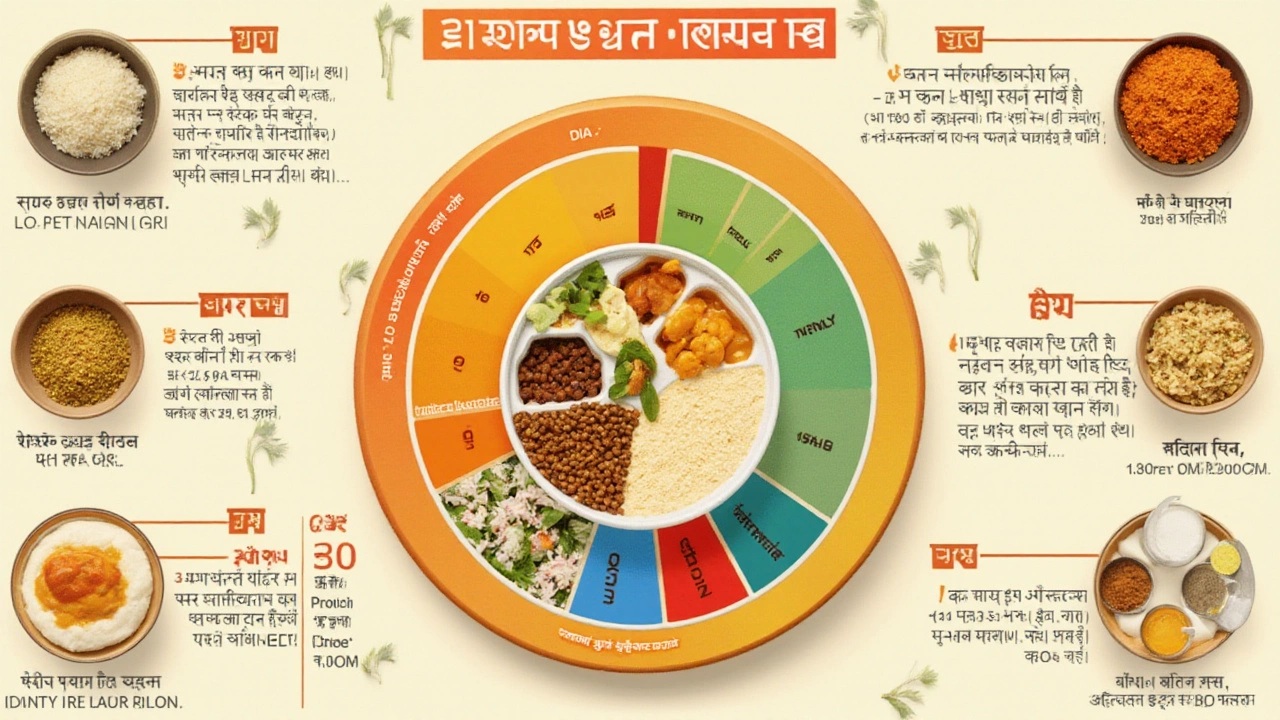
The world of diets is vast and varied, each promising to be your ticket to a healthier, happier life. Among these options, the 30 30 30 diet has emerged as a distinctive approach to shedding pounds while maintaining nutritional balance. What's intriguing about this plan is its emphasis on a relatively equal distribution of macronutrients, taking another look at the typical dietary routines most of us are accustomed to.
This diet invites you to allocate 30% of your daily caloric intake to protein, another 30% to carbohydrates, and the same amount to healthy fats, while leaving a flexible 10% to accommodate life's unpredictability. The goal is to nourish your body thoroughly while encouraging gradual and sustainable weight loss. By appreciating the balance between essential nutrients, this strategy promises to not only tackle weight-related challenges but also to enhance your relationship with food.
- Understanding the 30 30 30 Diet
- Benefits of the Diet
- How to Implement the 30 30 30 Diet
- Tips for Success
Understanding the 30 30 30 Diet
Delving into the 30 30 30 diet, one quickly understands it is not just another fleeting trend; it is a thoughtfully structured nutrition plan. The essence of this diet lies in its balanced approach, allocating your daily caloric intake into specific portions of macronutrients. A simplified view is that 30% of your calories should be derived from proteins, 30% from carbohydrates, and 30% from fats. The final 10% is left open-ended, allowing you the flexibility to enjoy a sweet indulgence now and then or to make adjustments on days when your routine goes awry. This plan is rooted in the idea of creating balance, promising both variety in nutrition and stability over time.
The reasoning behind this dietary breakdown is worth exploring. Proteins are crucial as they are the building blocks of our bodies, responsible for muscle repair and growth. Carbohydrates serve as the primary energy source, fueling everyday activities and workouts without making you feel sluggish. Healthy fats, often misunderstood, play vital roles in hormone regulation and nutrient absorption, ensuring the body functions seamlessly. By emphasizing these three macronutrients equally, the diet crafts a holistic approach to nutrition, going beyond mere calorie counting to making every calorie count. This method encourages the consumption of diverse food groups, helping you avoid monotony in meals and promoting a more enjoyable eating experience.
Interestingly, this structured approach aligns with several nutritional guidelines debated over recent years. Take, for instance, the 2015 study published in the American Journal of Clinical Nutrition, which concluded that balanced intake of macronutrients could lead to significant improvements in metabolic health.
"The contemporary focus on macronutrient distribution rather than calorie restriction alone bespeaks a shift towards fostering sustainable eating habits," noted Dr. Ellen Aldridge, a prominent nutritionist, in the study. This highlights how the 30 30 30 diet matches the findings of recent research, providing a model that not only aims for weight loss but also nurtures long-term health benefits.
A key component of this diet is its flexibility. There are no rigid meal plans or restrictions on specific foods. Instead, the focus is on balance, enabling you to enjoy a variety of meals catering to your tastes and preferences. Imagine crafting a dinner plate richer in colors—grilled chicken or tofu for protein, quinoa or brown rice for carbs, and a vibrant salad drizzled with olive oil for healthy fats. Such meals are both nutrient-dense and satisfying, ensuring you feel full and content. This adaptability makes it feasible for individuals with varied dietary practices, aiding in its sustainability.
To those wary about fitting this diet into their lives, consider it not as a restrictive regimen but as an empowering nutritional guide. Whether you are at home or eating out, identifying your macronutrients can transform dining decisions into opportunities for health improvement. And the allowance of 10% leeway in daily caloric intake ensures that even a misstep won't put you off track. It strips away the guilt often associated with diets, replacing it with an understanding of food’s benefit to the body. As you identify with the core principles of the 30 30 30 diet, it becomes less of a diet and more of a lifestyle choice dedicated to balanced health.

Benefits of the Diet
The 30 30 30 diet isn't just another catchy weight loss plan; it is a thoughtfully balanced approach that aligns with how our bodies naturally crave fuel. By dividing caloric intake into an equitable distribution of macronutrients such as proteins, carbohydrates, and fats, this diet helps maintain a steady energy supply throughout the day. Imagine a car running smoothly on a balanced team of gears, that's how your body works when you give it the right fuel. Protein, making up 30% of this method, is essential for muscle repair and growth. This not only aids in building a stronger physique but is also crucial for your body's metabolic rate. Metabolism is like a gentle flame, and protein is the wood that keeps it burning steadily.
Carbohydrates, often eyed suspiciously in many diets, find their rightful place here at another 30% of your diet. They are key for providing immediate energy, something our brain and muscles rely on to perform daily tasks efficiently. It's important to choose complex carbohydrates that release energy slowly, keeping blood sugar levels stable and preventing those dreaded sugar crashes. Think whole grains and vegetables rather than refined sugars or processed snacks. Balancing the equation, fats also hold a critical position with 30% in the diet. Fats, especially the healthy kind like omega-3 fatty acids, contribute to brain health and support our bodies in absorbing vital nutrients such as vitamins A, D, E, and K.
Moreover, this dietary approach tends to inspire a healthier long-term relationship with food. By allowing yourself the flexibility of 10% of your calorie intake, you can indulge occasionally without feelings of deprivation, which is often the downfall of many restrictive diets. According to a 2019 study published in the International Journal of Obesity, diets that include moderation and flexibility result in higher adherence rates and more sustainable weight loss. With this method, you're more likely to stick around for the long haul, paving the way to a healthy lifestyle rather than just a temporary fix.
"For many, the breakdown of macronutrients in the 30 30 30 diet reflects a diet that is both enjoyable and easy to manage," remarks Dr. Edward Hill, leading nutritionist and author on balanced living. "Unlike fad diets, this approach encourages a sustainable balance that people can follow happily," he adds.
Finally, by embracing the philosophy behind the 30 30 30 diet, you might also notice improvements in mood and cognitive function. Our bodies are systems that thrive on balanced inputs, and when you provide the correct portions of proteins, carbs, and fats, the clarity and focus they can bring to thought and behavior are transformational. Our mental well-being is closely tied to our physical health, which is why eating in a balanced manner can support both mental clarity and fortify immune responses. After all, when you feel better and think more clearly, weight loss becomes a thrilling journey rather than an uphill battle.

How to Implement the 30 30 30 Diet
Embracing the 30 30 30 diet involves understanding and organizing your daily meals in a way that echoes balance and simplicity. To begin with, it's crucial to have a basic knowledge of macronutrients—protein, carbohydrates, and fats—because these will be your daily staples. Proteins can be sourced from a variety of foods such as lean meats, fish, beans, and legumes. Carbohydrates are abundant in whole grains, fruits, and vegetables, while fats are best derived from nuts, seeds, and oils like olive or coconut. It's like crafting a symphony of flavors and nutritional values on your plate, ensuring each component of the diet sings its part without overshadowing the others.
Start by mapping out your meals and snacks for the day; this is where the true game-changer lies. With 30% of your intake for each macronutrient, you can enjoy a breakfast omelet filled with a mix of eggs and vegetables complemented by an avocado and whole-grain bread. For lunch, consider a quinoa salad with grilled chicken and mixed greens tossed in a light vinaigrette. Dinner could be a sumptuous curry with lentils, served alongside brown rice and a handful of almonds for good measure. These meals not only make it easier to adhere to the diet but also eliminate the need for last-minute unhealthy choices.
To keep this diet sustainable, it's worth remembering a piece of advice from nutrition experts.
"Balance is not something you find, it's something you create," says American nutritionist Joy Bauer.This philosophy can transform your dietary habits by encouraging mindful eating. Pay attention to what your body feels like both before and after meals, and don't shy away from adjusting the portions to better suit your individual energy needs. Tracking what you eat through a journal or mobile app can provide valuable insights and keep your progress visible, which can be a huge motivator along the way.
Practicality becomes effortless when you make good use of planning tools. Begin with a grocery list with staples for the week, making the healthy choice the easy choice. Consider prepping larger batches of grains and proteins to reduce daily cooking time and keep stress at bay. Suddenly, those wild snack urges may subside when your pantry is stocked with nourishing options aligned with your effort to implement the 30 30 30 diet. Remember, it's not about perfection but developing a dietary approach that respects your lifestyle and provides long-term benefits.
While the emphasis is on uniformity of macronutrient distribution, there's a small allocation of daily flexibility—10%—to adapt to real-life scenarios. Whether it translates to a special treat or dining out with friends, this little leeway underlines the diet's approachability without sacrificing efficacy. It's how the 30 30 30 diet attempts to mimic a life of moderation, which can ultimately support weight management goals and enhance overall wellness.

Tips for Success
The journey with the 30 30 30 diet can be rewarding if approached with the right mindset and strategies. One of the foundational elements of success is planning. Preparing your meals ahead of time can alleviate the stress of last-minute decisions and ensure that you adhere to the 30% allocation of proteins, carbohydrates, and fats in each meal. Having a meal plan can also help when shopping, making sure you have the right ingredients to maintain this nutritional balance. Many dietitians recommend using a food diary to track your macronutrient intake, offering vital insights into areas where you might need to adjust.
Variety is another crucial aspect of thriving on the 30 30 30 diet. While embracing a dietary change, it’s important to enjoy meals that are both nutritious and satisfying. Ensure your meals incorporate a wide range of colors and flavors to keep your palate pleased. Proteins can range from meats and fish to legumes and nuts, while carbohydrates should focus on whole grains and vegetables. Healthy fats are essential, so consider avocados, olive oil, and nut butters as your allies in this plan. Remember, each macronutrient serves its unique function, with proteins supporting muscle repair, carbs providing energy, and fats aiding in nutrient absorption.
"Consistency is the key to success with any diet. By sticking to the plan, you're setting yourself up for long-term health benefits," advises Dr. Lisa Sanders, a well-regarded nutritionist.
Hydration plays a significant role in the success of any diet, including the 30 30 30 diet. Drinking enough water can help you distinguish between hunger and thirst, which helps with portion control. Aim to drink at least eight glasses a day; however, more may be necessary depending on your activity level and climate. Staying hydrated can also keep your metabolism running smoothly and efficiently. Incorporating activities like mindful eating into your routine can enhance the benefits of this diet, simply by making you more present during meals and less likely to overconsume.
It's also beneficial to embrace a degree of flexibility within your diet. Life's events can often throw you off course, but being adaptable and forgiving yourself when perfection isn’t possible is crucial. Allow the 10% flexibility in your calorie allocation to be your safety net on those challenging days. Over time, you’ll learn what works best for your body and lifestyle. As you progress, you may also find it beneficial to consult with a nutritionist or diet coach who can provide personalized advice and adjustments to maximize your success.
To keep motivated, consider setting realistic goals and celebrating each milestone. Whether it's fitting into an old pair of jeans or simply feeling more energetic every morning, celebrating these victories can provide the motivation necessary to continue. Don't hesitate to surround yourself with supportive friends or groups who share similar goals, creating an encouraging community.







